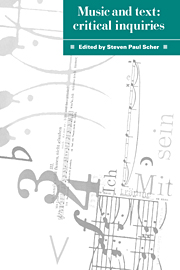Book contents
- Frontmatter
- Contents
- List of figures
- List of contributors
- Preface
- Acknowledgments
- Part I Institutional dimensions and the contexts of listening
- Part II Literary models for musical understanding: music, lyric, narrative, and metaphor
- Part III Representation, analysis, and semiotics
- 8 Music and representation: the instance of Haydn's Creation
- 9 Musical analysis as stage direction
- 10 Poet's love or composer's love?
- 11 The semiotic elements of a multiplanar discourse: John Harbison's setting of Michael Fried's “Depths”
- Part IV Gender and convention
- Index
9 - Musical analysis as stage direction
Published online by Cambridge University Press: 04 September 2009
- Frontmatter
- Contents
- List of figures
- List of contributors
- Preface
- Acknowledgments
- Part I Institutional dimensions and the contexts of listening
- Part II Literary models for musical understanding: music, lyric, narrative, and metaphor
- Part III Representation, analysis, and semiotics
- 8 Music and representation: the instance of Haydn's Creation
- 9 Musical analysis as stage direction
- 10 Poet's love or composer's love?
- 11 The semiotic elements of a multiplanar discourse: John Harbison's setting of Michael Fried's “Depths”
- Part IV Gender and convention
- Index
Summary
I propose here two linked ideas about Classical music theater. First, I suggest that each analytical observation about the musiccum-text intends (inter alia) a point of dramatic direction. Second and conversely, I suggest that each intuition we have about the behavior of characters on stage naturally seeks its validation (inter alia) through musical–textual analysis. To oversimplify the matter in a brief maxim: no analysis without direction; no directing without analysis. The maxim makes my ideas sound more like imperatives than they need be taken as here; for present purposes I will propose only that it is often fruitful to proceed according to the maxim. Meaning to demonstrate that method, rather than to promulgate my particular readings as such, I shall study fairly closely a short passage from Mozart's Le Nozze di Figaro. The passage, comprising a solo by the Count, and a subsequent solo by Basilio, opens the First Act trio “Cosa sento!”
We shall consider the Count's solo first. In numerous analysis courses I have found most people ready to articulate a directorial intuition that the Count is confused, uncomfortable, not in good control of himself or his situation. Most people will also articulate an analytic observation that the Count has trouble making a firm cadence on the tonic, that the cadence on “sento” is somehow unconvincing, that the Count must work hard – too hard – to achieve the eventual cadence at the end of his solo. These people readily accept the implications of the maxim here, that their directorial intuitions and their analytic observations about the music are bound together in a reciprocal relation.
- Type
- Chapter
- Information
- Music and TextCritical Inquiries, pp. 163 - 176Publisher: Cambridge University PressPrint publication year: 1992
- 1
- Cited by



